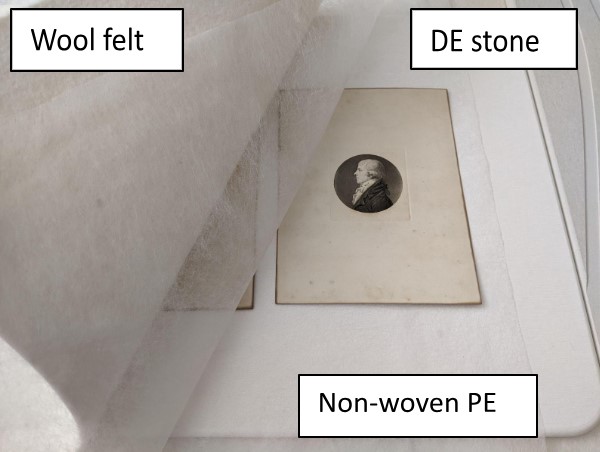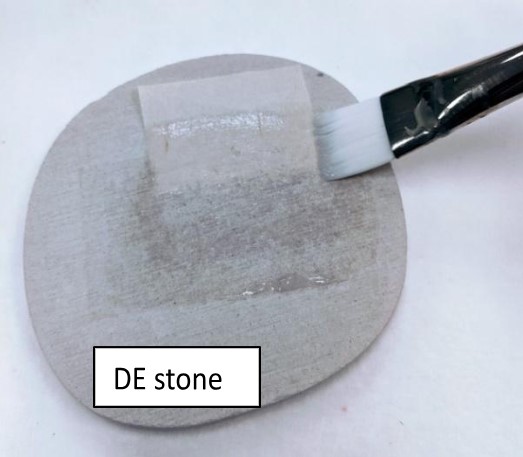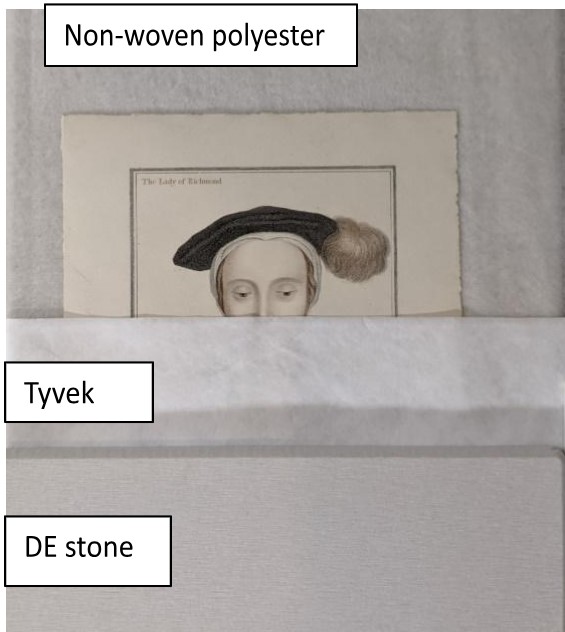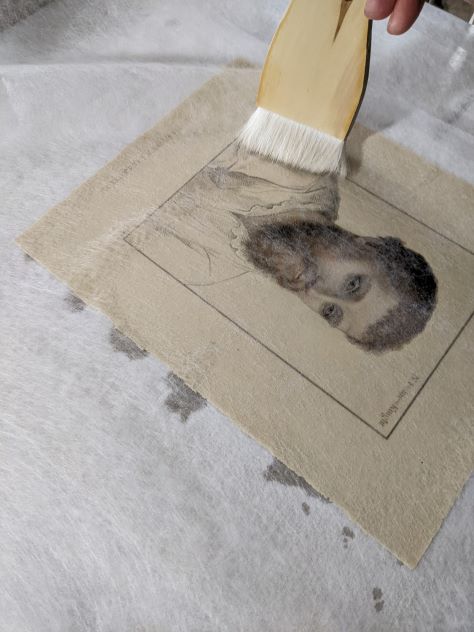Sustainability is an important issue for the field of paper conservation.
Diatomaceous earth (DE) stone mats are commercially available products marketed for home use, and, in my opinion, they could help paper conservators maintain a more sustainable practice. According to advertisements, the product is composed of all-natural materials without any additives, is safe for human use, dries incredibly quickly and resists bacterial and mould growth.
Diatomaceous earth stone mats are sold for kitchen or bathroom use and come in a variety of sizes. These stones are highly absorbent, dimensionally stable, rigid and reusable. They could be a viable alternative to paper blotters, providing a sustainable drying surface for various paper conservation procedures. In addition, they could be used as a rigid and absorbent surface for removing excess water from an object after an aqueous treatment, or as a pasting-out surface for paper attachments, mending strips or even lining paper.
I routinely use DE stones instead of paper blotters to dry wet or humidified paper objects. When the paper artefact has a plate mark or some other 3D quality, I combine the DE stone with a sheet of wool felt. Whether in drying procedures or otherwise, I recommend using a non-woven polyester separation layer, as shown in Figure 1. It is also a good practice to rinse and dry a brand new stone before its first use to remove any loose dust.


Fig. 2 – An intaglio print is dried between DE stones with a piece of wool felt. Photography by Ewa Paul.
Fig. 3 – A lithograph (right) is dried between two DE stones with an isolating layer of non-woven polyester fabric. Photography by Ewa Paul.
DE stones are available in various sizes and shapes from many different companies, such as Dorai Home, Sutera, Earthstone and many more. They can be purchased online. The prices vary depending on the brand and size you pick. While I find a single large stone the most practical for creating a larger drying surface, I routinely use all these sizes:
- 23.6” x 15.4” x ¼” (a single large stone);
- 31.6“ x 22.3” x ¼” (a mat consisting of four separate stones, each measuring 11” x 16” x ¼”);
- 4 x 4 x ¼” (a coaster-sized stone).


Fig. 4 – Pasting out a hinge on a 4” x 4” stone. Photography by Ewa Paul.
Fig. 5 – Various types of diatomaceous earth stone products are shown above. Diatomaceous earth comes in various colours, from white to brown-grey; DE stones come in different shades of white and grey. Photography by Ewa Paul.
The coaster-sized 4” x 4” stone (Fig. 4) can be used for pasting out hinges. The stone quickly removes moisture, reducing the risk of tidelines (especially when hinging an unwashed or water-sensitive object). The adhesive residue can be washed off the stone later with a soft brush under running water. A stone fully saturated with water takes about 24 hours to dry.
If minimal moisture is required during a lining procedure, it is possible to paste out larger sheets of lining paper on the DE stone. In that instance, I recommend using a lightweight, non-woven polyester fabric as a separation layer rather than pasting directly on the stone. Otherwise, a larger piece of paper may stick to the stone, as the moisture is removed quite rapidly.
For flattening, I recommend using a non-woven polyester fabric such as Hollytex as the isolating layer, but it can be replaced with a sheet of Tyvek (Fig. 5) when a paper object has a calendared, smooth surface.
Fig. 6 – Flattening a print with Tyvek instead of Hollytex as the interlayer. This helps preserve the surface appearance of very smooth papers. Photography by Ewa Paul.
Fig. 7 – A print that underwent an aqueous treatment is resting on a DE stone to remove excess water; the paper is brushed over a layer of non-woven polyester to ensure even contact with the stone. The dark spots visible along the edge of the engraving are wet areas of the DE stone. Photography by Ewa Paul.
The advantages of DE stones are their rapid absorption, rigidity, dimensional stability, reusability and the inert quality of the material. Dr. Jennifer Herrmann has analysed samples of DE stones using FTIR and XRF and found no evidence of any detrimental organic components (publication pending). She also found no evidence that any residues were transferred from the stones onto paper when the stones were used for drying. In the drying experiment, a polyester non-woven barrier was not used.
The disadvantage of this product is that it is smaller than a blotter sheet; the largest stones are 38 cm x 61 cm x 0.8 cm (23.5” x 15.5” x 3/8”). The stones also have rounded corners, so combining more than two stones to create a larger surface will leave a corner joint gap. Finally, these are commercially manufactured products and can be discontinued or changed without warning.
The research on the efficacy of the diatomaceous earth stones was done jointly with Dr. Jennifer Herrmann, a heritage scientist at the National Archives and Records Administration in Washington DC. This information was presented as a poster at the 2023 AIC conference in Jacksonville, FL and at the 2023 IADA XV Congress in Halle/Leipzig.
I would like to thank my colleagues from the US National Archives and Records Administration, as well as Lilli Steele and Sylvia Albro from the The Phillips Collection, for their help and encouragement to complete this project. I would also like to acknowledge Milena Paul for making the diagram used in the text above.
Ewa Paul is a paper conservator at the National Archives in Washington DC; she joined the conservation team full-time in March 2023. Ewa has been in private practice in Fairfax, VA, USA since 2014. She also worked as a contract paper conservator at The Phillips Collection, the NMAH and many other institutions in the greater Washington DC area. Between 2010 and 2012, Ewa volunteered at the Rising Museum in Warsaw, Poland. She was a Neukom conservation fellow at the US Holocaust Memorial Museum in 2003 and is a graduate of the Buffalo Art Conservation Program in the USA.
If you have a question or would like more information on the DE stones, please feel free to email me at ewampaul@gmail.com.



A most interesting read. Will follow that up.
LikeLiked by 1 person
Very interesting and inspiring! I will definetly try it. Thanks for sharing in such detail.
LikeLike
Great article!
LikeLike
Thank you Rita. Do let me know how you like it.
LikeLike